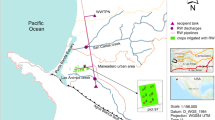Abstract
Irrigation with municipal effluent was evaluated during 25 months in Southern Iran from 2003 to 2005 in which 14 tree species were irrigated with effluent and borehole water at an annual supply rate of 3,940 and 5,395 m3 ha−1, respectively. To mitigate the environmental effects, a drip irrigation system was designed and the amount of applied water based on pan evaporation was measured by flow meters and soil properties were monitored. The statistical results showed that the applied effluent had no adverse effect on soil properties. The soil salinity was reduced from 8.2, 6.8 and 7.0 dSm−1 to 1.07, 1.12 and 3.5 dSm−1 in the soil layers 0–30, 30–60 and 60–90 cm, respectively. The SAR decreased significantly, while soil pH increased by 0.8 and 0.6 units in the layers 0–30 and 30–60 cm. A total application of 9,335 m3ha−1 of effluent with a nitrogen and phosphorus concentration of 7.9 and 10.3 mg l−1, added 73 and 101 kg ha−1 of nitrogen and phosphorus to the soil. Organic carbon also increased significantly. Twenty-five months irrigation with effluent caused a slight increase in soil bulk density and a slight decrease in mean permeability. Because of an efficient filtration and high discharge rate of bubblers (drippers), no considerable sign of clogging was observed.
Similar content being viewed by others
References
Abbott, C. L., & Quosy, D. E. D. EL. (1996). A procedure to assess the impacts of drain water reuse. Cairo: Report OD 134, HR Wallingford in collaboration with the Water Management Research Institute.
APHA (American Public Health Association), American Water Work Association, Water Pollution Control Federation (1990). Standard methods for the examination of water and wastewater, 19th Edition. Washington, DC: APHA.
Ayers, R. S., & Westcott, D. W. (1985). Water quality for agriculture, FAO, irrigation and drainage paper no. 29 (Rev. 1). Rome, Italy, 176.
Cromer, R. N. (1980). Irrigation of radiata pine with wastewater: a review of the potential for tree growth and water renovation. Australian Fare, 43, 87–100.
Cromer, R. N., Tompkins, D., Barr, N. J., & Hopkins, P. (1984). Irrigation of monterey pine with wastewater: Effect on soil chemistry and groundwater composition. Journal of Environmental Quality, 13(4), 539–542.
CSIRO (1999) Sustainable effluent-irrigated plantations: An Australian guideline. Canberra, Australia, 286.
Garg, S. K. (2004). Irrigation engineering and hydraulic structures. Delhi: Khanna Publishers, 1530.
Hanna, D., Boardman, R., Grams, S., Dillon, P., & Lucks, V. (1994). Nutrient, solute and water distribution in Australian native hardwoods plantation irrigation with reclaimed water from Bolivar Sewage Treatment Works. Adelaide, Australia: International Congress on Water Down Under 94.
Hassanli, A. M., & Javan, M. (2005). Using municipal effluent in plantation with trickle irrigation systems with minimum environmental effects. Proceedings of 5th International Conference on Wastewater Reclamation and Reuse for Sustainability, Korea, Nov. 7–11, 141.
Myers, B. J., Bond, W. J., Benyon, R. G., Falkiner, R. A., Polglase, P. J., Smith, C. J., et al. (1999). Sustainable effluent-irrigated plantation: An Australian guideline. Canberra, Australia: CSIRO Forestry and Forest Products.
Olsen, S. R., Cole, C. V., Watanabe, F. S., & Dean, L. A. (1958). Estimation of available phosphorus in soils by extraction with NAHCO 3 . USDA Circular No. 939.
Page, A. L., Miller, R. H., & Keeney, D. R. (1982). Methods of soil analysis, part 2, chemical and microbiological properties. Madison, WI: American Society of Agronomy, Soil Science of America.
Schrale, R., Boardam, R., & Blaskett, M. J.(1993). Investigating land based disposal of Bolivar reclaimed water, South Australia. Water Science and Technology, 27(1), 87–96.
Sheltered, J. (1994). Using water of marginal quality for crop production major issues. Agricultural Water Management, 25, 233–269.
Stewart, H. T. L., & Flinn, D. W. (1984). Establishment and early growth of trees irrigation with waste water at four sites in Victoria, Australia. Forest Ecology and Management, 8, 243–256.
Stewart, H. T. L., Hopmans, P., & Flinn, D. W. (1990). Nutrient accumulation in trees and soil following irrigation with municipal effluent in Australia. Journal of Environmental Pollution, 63, 155–177.
Urie, D. H. (1986). The status of wastewater irrigation of forests. In D. W. Cole, C. L. Henry, & W. L. Nutter (Eds.), Is the forest alternative for treatment and utilization of municipal and industrial wastes (pp. 26–40). Seattle and London: University of Washington Press.
Walkley, A., & Black, C. A. (1934). An examination of the method for the determination soil organic matter and a proposed modification of the chromic acid titration method. Soil Science, 37, 29–38.
WHO. (1989). Health guidelines for the use of wastewater in agriculture and aquaculture. Technical Report No. 778. Geneva: World Health Organization.
Author information
Authors and Affiliations
Corresponding author
Rights and permissions
About this article
Cite this article
Hassanli, A.M., Javan, M. & Saadat, Y. Reuse of municipal effluent with drip irrigation and evaluation the effect on soil properties in a semi-arid area. Environ Monit Assess 144, 151–158 (2008). https://doi.org/10.1007/s10661-007-9953-2
Received:
Accepted:
Published:
Issue Date:
DOI: https://doi.org/10.1007/s10661-007-9953-2




